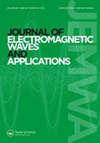基于压缩感知的时调制阵列故障诊断
IF 1.1
4区 工程技术
Q4 ENGINEERING, ELECTRICAL & ELECTRONIC
Journal of Electromagnetic Waves and Applications
Pub Date : 2023-10-18
DOI:10.1080/09205071.2023.2270517
引用次数: 0
摘要
摘要时调制阵列(tma)具有较高的设计自由度以提高其辐射性能,但由于其硬件特性,tma容易出现故障。在本文中,我们提出了一种基于压缩感知(CS)的TMAs损伤诊断新技术。将TMA诊断问题重新表述为中心频带和边带的稀疏信号恢复问题。在此基础上,提出了一种基于凸集理论与序列凸规划(DCS-SCP)的TMAs损伤诊断方法。利用同一位置不同频率的少量远场测量,采用混合10 / 12范数最小化方法实现了中心频率和边带等效激励的联合恢复。数值模拟和与现有算法的成功比较表明,该方法在噪声鲁棒性和诊断精度方面具有优越性。关键词:阵列故障压缩感知凸编程时调阵列公开声明作者未报告潜在的利益冲突。郭白,2019年毕业于中国成都信息工程大学,获电子信息科学与技术专业学士学位。他目前在中国西南交通大学物理科学与技术学院攻读哲学博士学位。主要研究方向为天线阵列诊断算法、阵列综合算法、计算电磁学和电磁优化算法。廖成,1995年毕业于中国电子科技大学电磁场与微波技术专业,获博士学位。1997年至1998年,他是香港九龙塘城市大学的访问学者。他于1998年成为西南交通大学教授。主要研究方向为高功率微波技术、计算电磁学、天线技术。程友峰,博士,2018年毕业于中国电子科技大学,获射电物理学博士学位。2017年,他以访问学者的身份加入美国德克萨斯州休斯顿市休斯顿大学机械工程系。2018年,他加入了中国成都的西南交通大学。现任西南交大电磁学研究所副教授。他撰写或合作撰写了40多篇同行评审论文。主要研究方向为相控阵、可重构天线、低rcs天线、阵列分析与合成、进化算法等。LiuYuanzhi LiuYuanzhi (IEEE学生会员),2019年毕业于中国成都信息工程大学,获电子学学士学位。他目前正在攻读文学硕士学位。获得加拿大渥太华大学电气与计算机工程学位。主要研究方向为天线设计、计算电磁学、射频/微波电路。Feng, 2014年获西南交通大学电磁场与微波技术专业博士学位。现任西南交通大学电磁场与微波技术研究所副教授。主要研究方向为天线理论与设计、计算电磁学、电磁波传播。钟宣明,2003年毕业于中国成都西南交通大学,获学士和硕士学位。2012年起任西南交通大学副教授。主要研究方向为高功率微波技术、计算电磁学、天线技术。本文章由计算机程序翻译,如有差异,请以英文原文为准。
Failure diagnosis for time-modulated arrays based on compressed sensing
AbstractTime-modulated arrays (TMAs) have a high design degrees of freedom (DoFs) to improve radiation performance, while they are prone to failure due to their hardware characteristics. In this article, we propose a novel technique to diagnose impaired TMAs based on compressed sensing (CS). The TMA diagnosis problem is reformulated as a sparse signal recovery problem at the center frequency and sidebands. Then, a method based on the difference of convex sets theory and sequential convex programming (DCS-SCP) is developed to implement diagnosis for impaired TMAs. Using a small number of far-field measurements at the same position but different frequencies, the joint recovery of the equivalent excitations at the center frequency and sidebands is realized by a mixed l0/l2-norm minimization method. The numerical simulation and the successful comparison with the state-of-the-art algorithms demonstrate the superiority of the proposed methods in terms of noise robustness and diagnosis accuracy.Keywords: Array failurecompressed sensingconvex programmingtime-modulated arrays Disclosure statementNo potential conflict of interest was reported by the author(s).Additional informationNotes on contributorsGuo BaiGuo Bai received the B.E. degree in electronic information science and technology from the Chengdu University of Information and Technology, China, in 2019. He is currently pursuing the Ph.D. degree in philosophy with the School of Physical Science and Technology, Southwest Jiaotong University, China., His research interests include antenna array diagnosis algorithms, array synthesis algorithms, computational electromagnetic and electromagnetic optimization algorithms.Cheng LiaoCheng Liao received the Ph.D. degree in electromagnetic fields and microwave techniques from the University of Electronic Science and Technology of China (UESTC), Chengdu, China, in 1995. From 1997 to 1998, he was a Visiting Scholar at the City University of Hong Kong, Kowloon Tong, Hong Kong. He became a Professor with Southwest Jiaotong University, Chengdu, China, in 1998. His research interests include high-power microwave technology, computational electromagnetic, and antenna.You-Feng ChengYou-Feng Cheng received the Ph.D. degree in radio physics from the University of Electronic Science and Technology of China, Chengdu, China, in 2018. In 2017, he joined the Mechanical Engineering Department, University of Houston, Houston, TX, USA, as a Visiting Scholar. In 2018, he joined Southwest Jiaotong University (SWJTU), Chengdu, China. He is currently an Associate Professor with the Institute of Electromagnetics, SWJTU. He has authored or coauthored more than 40 peer reviewed papers. His research interests include phased arrays, reconfigurable antennas, low-RCS antennas, array analysis and synthesis, and evolutionary algorithms.Yuanzhi LiuYuanzhi Liu (Student Member, IEEE) received the B.Eng. degree in electronics from the Chengdu University of Information Technology, Chengdu, China, in 2019. He is currently pursuing the M.A.Sc. degree in electrical and computer engineering with the University of Ottawa, Ottawa, ON, Canada.,His research interests include antenna design, computational electromagnetics, and RF/microwave circuits.Ju FengJu Feng received the Ph.D. degree in electromagnetic field and microwave technology from Southwest Jiaotong University, Chengdu, China, in 2014.,She is currently an Associate Professor with the Institute of Electromagnetic Field and Microwave Technology, Southwest Jiaotong University. Her major research interests include antenna theory and design, computational electromagnetics, and electromagnetic wave propagation.Xuanming ZhongXuanming Zhong received the Bachelor's and Master's degrees from Southwest Jiaotong University, Chengdu, China, in 2003. Since 2012, he has been an Associate Professor with Southwest Jiaotong University. His research interests include high-power microwave technology, computational electromagnetic, and antenna.
求助全文
通过发布文献求助,成功后即可免费获取论文全文。
去求助
来源期刊
CiteScore
3.60
自引率
7.70%
发文量
116
审稿时长
3.3 months
期刊介绍:
Journal of Electromagnetic Waves and Applications covers all aspects of electromagnetic wave theory and its applications. It publishes original papers and review articles on new theories, methodologies, and computational techniques, as well as interpretations of both theoretical and experimental results.
The scope of this Journal remains broad and includes the following topics:
wave propagation theory
propagation in random media
waves in composites and amorphous materials
optical and millimeter wave techniques
fiber/waveguide optics
optical sensing
sub-micron structures
nano-optics and sub-wavelength effects
photonics and plasmonics
atmospherics and ionospheric effects on wave propagation
geophysical subsurface probing
remote sensing
inverse scattering
antenna theory and applications
fields and network theory
transients
radar measurements and applications
active experiments using space vehicles
electromagnetic compatibility and interferometry
medical applications and biological effects
ferrite devices
high power devices and systems
numerical methods
The aim of this Journal is to report recent advancements and modern developments in the electromagnetic science and new exciting applications covering the aforementioned fields.

 求助内容:
求助内容: 应助结果提醒方式:
应助结果提醒方式:


